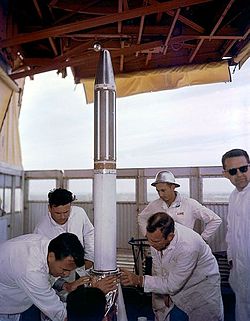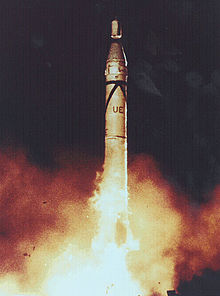Explorer 1
| Explorer 1 | |||||||
|---|---|---|---|---|---|---|---|
| Phase : F / Status : burned out | |||||||
 Explorer 1 preparing to start |
|||||||
| Type: | Research satellite | ||||||
| Country: |
|
||||||
| COSPAR designation : | 1958-001A | ||||||
| NORAD / SCN-ID : | 4th | ||||||
| Mission dates | |||||||
| Start date: | February 1, 1958, 03:48 UTC | ||||||
| Starting place: | Cape Canaveral , LC-26A | ||||||
| Launcher: | Jupiter-C / Juno I RS-29 | ||||||
| Mission duration: | 4,441 days / 12 years and 2 months | ||||||
| End date: | March 31, 1970 | ||||||
| Orbit data | |||||||
| Origin of coordinates: | earth | ||||||
| Rotation time : | 114.8 min | ||||||
| Apogee : | 2,550 km | ||||||
| Perigee : | 358 km | ||||||
| Eccentricity : | 0.140 | ||||||
| Orbit inclination : | 33.24 ° | ||||||
| General spacecraft data | |||||||
| Takeoff mass: | 13.9 kg | ||||||
| Dimensions: | 205 cm length, 16 cm diameter | ||||||
| Manufacturer: | Jet Propulsion Laboratory | ||||||
| Specific spacecraft data | |||||||
| Payload: | Mass: 8.3 kg | ||||||
| Payload data | |||||||
| Instruments: |
|
||||||
| Others | |||||||
| Previous mission: |
Vanguard TV3 | ||||||
| Subsequent mission: |
Vanguard TV3BU | ||||||
|
|||||||
Explorer 1 was the first artificial Earth satellite in the USA (1958) and the third worldwide after the two satellites Sputnik 1 and 2 of the Soviet Union . In the media, the launch of the satellite is sometimes referred to as "America's answer to the Sputnik shock ".
Geophysics and rocket science
Explorer 1 was the first satellite in the Explorer program , which was the first and most extensive program of satellites and spacecraft in the United States. Most of them (over 80) were extremely successful and were used to study the ionosphere , geography ( remote sensing ), and astronomy .
The scientific reason for Explorer 1 was polar or ionospheric research and the (first) International Geophysical Year 1957/58. The launch had already been announced by the US President in July 1955 (four days later a similar announcement was made by the Soviet Union, which then launched the first satellite in front of the USA).
But military and technical reasons also played a role ( Cold War , ICBMs).
Explorer 1 as a replacement for Vanguard
Explorer 1 was launched on February 1, 1958 at 3:48 UTC (January 31 at 10:48 p.m. local time ) from launch pad 26 of Cape Canaveral Air Force Station . The launch window was open for four hours, between 3:30 UTC and 7:30 UTC.

Originally, the satellite was supposed to be launched two days in advance - but the launch had to be postponed twice due to bad weather conditions ( jet stream ). Also on the day of the start it was not certain whether the wind speeds would decrease.
Was started Explorer 1 with the four-stage launch vehicle of the type Juno I , a slight modification of the medium-range missile Jupiter C . The launch pad was near Cape Canaveral on the long peninsula on the Atlantic coast of Florida .
Explorer 1 consisted of a 205 cm long cylinder 16 cm in diameter and reached an elliptical orbit between approximately 360 km and 2,530 km in altitude. With a total weight of 13.9 kg, the payload was 8.3 kg. Explorer 1 was equipped with telemetry antennas and geophysical measuring instruments - u. a. those magnetometers used to detect the Van Allen radiation belt around the earth.
For political reasons, a probe built by the US Navy - the small Vanguard 1 - was originally intended to be the USA's first artificial satellite. After the false start on December 6, 1957 (the three-stage launcher had not yet been tested), Wernher von Braun was, at his insistence, given permission to launch a satellite into orbit.
Explorer 1 was significantly smaller and lighter than the Soviet Sputnik , but provided a lot of measurement data about the ionosphere , which indicated a radiation belt (later named Van Allen Belt ) around the earth. With later explorer launches, the radiation belt - and a second one outside it - was explored more closely and proved to be dangerous for manned space travel , whose preliminary planning had been going on for some time.
CalTech, von Braun and the V2
The satellite was planned and built by the Jet Propulsion Laboratory ( JPL ) of the California Institute of Technology ( Caltech under William H. Pickering). The measuring instruments were developed by James Van Allen , the Jupiter rocket was a modification of the medium -range rocket of the Redstone type . It came from the workshops of the ABMA (Army Ballistic Missile Agency) under the direction of Wernher von Braun , the former German rocket pioneer in Peenemünde . The Jupiter-C was a direct "descendant" of the German A4 (V2) and was developed in 1955–56.
Slow descent of orbit
Over time, the orbit slowly sank due to the braking effect of the uppermost air layers ( exosphere ) - an average of 30 km per year. From this - as with the first Soviet satellites - the model of the high earth atmosphere could be improved as early as 1958/59 . The air density assumed up to now had been set too low several times. After 12 years in space, Explorer 1 burned up on March 31, 1970 at an altitude of about 100 km.
Start process
| Time (after T + 0) | event |
|---|---|
|
0.0 s
|
Lift-off |
|
156.8 s
|
Burnout 1st stage |
|
160.7 s
|
Stage separation |
|
394.4 s
|
Ignition 2nd stage |
|
402.4 s
|
Ignition 3rd stage |
|
410.4 s
|
Ignition 4th stage |
|
416.4 s
|
Orbit reached |
See also
literature
- NASA Facts: Explorers: Searching the Universe Forty Years Later . 1998.
- Moonwatch Newsletter Vol. 6, Smithsonian Observatory , Mass./USA 1958 .
- Bernd Leitenberger: US launch vehicles. 2016.
Web links
- NASA: Explorer Series of Spacecraft (English)
- NASA: Explorer-I and Jupiter-C (English)
Individual evidence
- ↑ Orbit data according to Explorer 1 in the NSSDCA Master Catalog , accessed on October 8, 2012 (English).
- ↑ Horst Rademacher: America's answer to the Sputnik shock , in Frankfurter Allgemeine Zeitung, January 31, 2018, accessed online April 7, 2018

